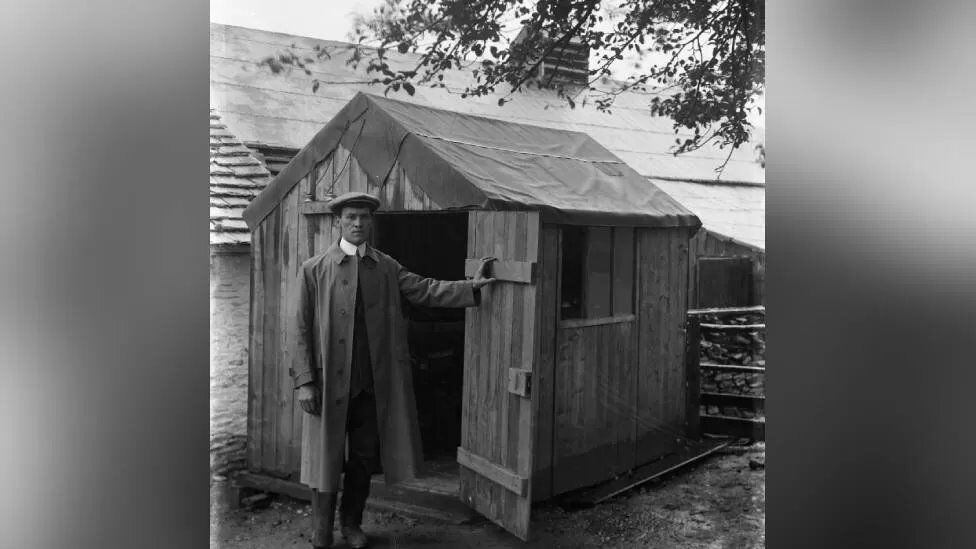when the titanic struck an iceberg while crossing the Atlantic in 1912, its telegraphers desperately sent out distress calls in the hope that someone, somewhere might hear them.
One of the first to respond was a radio amateur who was some 3,000 miles away, in United Kingdom.
LOOK: The detailed images of the Titanic that show the famous shipwreck as you have never seen it before
The self-taught Arthur Moore he received the signal at the station he himself had created in the town of Blackwood, in south Wales.
After hearing the call, he ran to the local police station, but once there his story was not taken seriously.
And while the radio enthusiast couldn’t do anything to help those aboard the Titanic, he later developed an early form of sonar technology that helped discover decades later the place where the ship rested.
born inventor
“Artie,” as the locals called him, was already known for his radio equipment a year before the Titanic sank.
In 1911, there were intercepted the Italian government’s declaration of war on Libyaa feat that landed him on the cover of the British tabloid Daily Sketch.
Born in 1887, Artie and his brother took over running a mill from their father and were pioneers and entrepreneurs.
According to Lyn Pask, president of the Blackwood History Society, the brothers owned “some of the first automobiles in the Gwent region,” developed machines for local farmers, and gave the area its “first access to electricity.” by charging batteries from the generator they had created, powered by the waterwheel of the mill”.
But Artie’s love of engineering stemmed from a tragedy.
After lose a leg as a young man in an accident at the mill, he was inspired for his first invention: a counterweight on his bicycle that allowed him to ride, pushing down with his good foot.
His scale model of a steam locomotive won a magazine contest.
The prize was a book called “Modern Views of Magnetism and Electricity”, which sparked his interest in radiotelegraphy.
Weirdo
Ham radio enthusiast Billy Crofts, who now lives in London but originally hails from Wales, says that at the time Artie was seen as a weirdo.

“He hung all these antennas made of thin strands of copper wire from the Gelligroes mill, over the nearby River Sirhowy, and among the trees on the side of an old barn,” Crofts says.
As a result, he explains, Artie could receive radio messages from further away than anyone had ever achieved or believed possible before.
“People thought he was crazy and that believing he could intercept signals through wires was something akin to paranormal psychology.”
Recognition
That was undoubtedly the reaction of the local police when, in the early hours of April 15, 1912, Artie cycled to the station to report the SOS calls from the Titanic.
“Aha,” said the police mocking him. We’ll take a look. Go back to bed now and don’t bother anymore.
Although, according to Pask, out of South Wales, Artie was taken very seriously.

“Very soon, newspaper reports appeared and corroborated every detail of what Artie had told the police, even down to Titanic’s use of the recently adopted SOS distress signal.”
“At Blackwood it might have been considered black magic, but to those who knew and understood, wireless telegraphy was the Internet of the day.”
Pask says that Artie’s “genius” was soon noticed by some “very important people.”
Between them, Guglielmo Marconian inventor of radiotelegraphy
He had originally predicted that the radio signals could exceed 2,000 miles, but Artie had received them over 3,000 miles away.
Within a year, Marconi had hired the hobbyist for his wireless company.
As Marconi’s apprentice, Artie designed the first communications that could travel between Great Britain and the Falklands (Malvinas) Islands during World War I.
In World War II, it was pioneer in creating an early form of sounda technique that uses sound to navigate, measure distances, and communicate with objects in the water.
This helped guide Allied ships around German U-boats in the North Atlantic.

Artie retired to Jamaica in 1947, but soon after developed leukemia and returned to the city of Bristol in the United Kingdom for treatment, where he died a year later.
In 1985, 73 years after his radio tuned in to calls for help from the Titanic, it was the sonar technology he developed that was used to discover his final resting place on the Atlantic seabed.
Source: Elcomercio
I am Jack Morton and I work in 24 News Recorder. I mostly cover world news and I have also authored 24 news recorder. I find this work highly interesting and it allows me to keep up with current events happening around the world.

:quality(75)/cloudfront-us-east-1.images.arcpublishing.com/elcomercio/TLFZE2IZ2FAMBBEFNDHZGTPII4.jpg)





